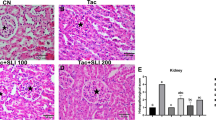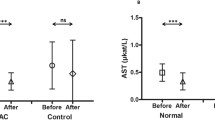Abstract
Objective: To determine the efficacy of ademetionine (S-adenosylmethionine, SAME) administration in preventing hepatotoxicity in patients undergoing long-term cyclosporin treatment.
Design: Randomised, controlled, double-blind trial followed up for 3 months.
Setting: Subjects were studied for a period of 10 days in hospital and then followed up in the outpatient unit for 3 months.
Patients: 72 male patients with psoriasis, of whom 36 were treated with cyclosporin and 36 with cyclosporin plus ademetionine.
Interventions: Cyclosporin treatment alone (10 mg/kg/day) was compared with treatment with the same dosage of cyclosporin in combination with ademetionine 400 mg/day.
Main outcome measures: Serum fractioned bilirubin, γ-glutamyltransferase, alkaline phosphatase and transaminases, plasma malondialdehyde and 4-hydroxynonenal, and erythrocyte glutathione peroxidase were determined.
Results: Hepatotoxicity and cholestasis were observed in 15 of 36 patients treated with cyclosporin alone, whereas no cases of liver cytotoxicity were observed in the group treated with cyclosporin in combination with ademetionine (p < 0.005). Moreover, the study results revealed a significant difference in oxidation-reduction balance between the two groups, with more marked oxidative stress in patients on cyclosporin alone.
Conclusions: Ademetionine may protect the liver against potentially hepatotoxic substances, such as cyclosporin, and coadministration of ademetionine should therefore be considered when hepatotoxic drugs are used.




Similar content being viewed by others
References
Britton RS, Bacon BR. Role of free radicals in liver diseases and hepatic fibrosis. Hepatogastroenterology 1994;41: 343–8
Pietrangelo A. Metals, oxidative stress, and hepatic fibrogenesis. Semin Liver Dis 1997; 16: 13–30
Frezza M, Surrenti C, Manzillo G, et al. Oral S-Adenosylmethionine in the symptomatic treatment of intrahepatic cholestasis. A placebo-controlled study. Gastroenterology 1990; 99: 211–5
Frezza M, Terpin M. The use of S-adenosylmethionine in the treatment of cholestatic disorders. A metanalysis of clinical trials. Drug Invest 1992; 4: 101–8
Galàn AL, Munoz ME, Jiménez R. Role of S-adenosylmethionine on cyclosporine-induced cholestasis and hepato-toxicity: effects on liver plasma membrane composition, fluidity and functions. Proceedings of the Workshop on Methionine Metabolism: molecular mechanisms and clinical implications. Sierra Nevada Granada (Spain) March 1–5 1998
Di Perri T, Sacco T, Festi D, et al. Ademethionine in the treatment of chronic hepatic disease. A multicentre study. Gastroenterology Int 1999; 12: 62–8
Concari M, Guicciardi ME, Carrubi F. S-Adenosylmethionine reduced hepatic-toxicity induced by hydrophobic bile salt in HepG2 cell line. J Hepatol 1994; 21: S77
Mato JM, Càmara J, de Paz JF, et al. Adenosylmethionine in alcoholic liver cirrhosis: a randomised, placebo control, double-blind, multicenter clinical trial. J Hepatol 1999; 30: 1081–9
Mato JM, Càmara J, Ortiz P, et al. Adenosylmethionine in the treatment of alcoholic liver cirrhosis: results from a controlled, randomised, double-blind, clinical trial. Hepatology 1997; 26: A489
Yagy K. Assay for serum lipid peroxide level and its chemical significance. In Yagy K ed: Lipid peroxides in biology and medicine. New York: Academic Press 1982; 223–242
Esterbauer H, Cheeseman KH. Determination of aldehydic lipid peroxidation products: malonaldehyde and 4-hydroxynonenal. Methods Enzymol 1990; 186: 407
Paglia DE, Valentine WN. Studies on the quantitative and qualitative characterisation of erythrocyte glutathione peroxidase. J Lab Clin Med 1967; 70: 158
Satoshi M, Shigeo K. Mechanisms of action of cyclosporine. Immunopharmacology 2000; 47: 119–125
Acknowledgements
This manuscript was supported by a grant from the Italian University Ministry (MURST). The authors thank Ms Moira Mcpherson for her assistance in translation.
Author information
Authors and Affiliations
Rights and permissions
About this article
Cite this article
Neri, S., Signorelli, S.S., Ierna, D. et al. Role of Ademetionine (S-Adenosylmethionine) in Cyclosporin-Induced Cholestasis. Clin. Drug Investig. 22, 191–195 (2002). https://doi.org/10.2165/00044011-200222030-00006
Published:
Issue Date:
DOI: https://doi.org/10.2165/00044011-200222030-00006




